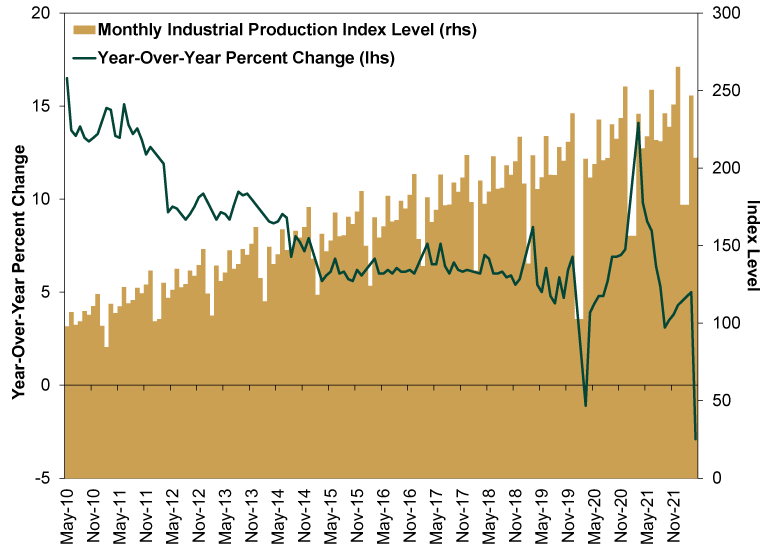Personal Wealth Management / Market Analysis
Our Take on China’s Weak April Data
While the magnitude of the economic contraction surprised observers, lockdowns’ taking a toll was a foregone conclusion.
China’s National Bureau of Statistics (NBS) released the rest of its April economic data overnight Sunday, and as you may have surmised given Shanghai and other major economic centers remain under heavy COVID restrictions, the results weren’t pretty. In a press release titled “General Trend of High-Quality Development Remained Unchanged Despite the Increased Downward Pressure on Economy,” the NBS revealed retail sales’ contraction deepened, services output fell hard, industrial production flipped negative and fixed asset investment slowed. The release highlighted strength in information technology-related services as a silver lining, but we think it is better for investors to just look the weakness in the eye. For stocks don’t move on what just happened, but rather what happens over the next 3 – 30 months, and we see a strong case for growth to resume in relatively short order, helping ease global economic uncertainty.
For nearly two months now, analysts have tried to assess the economic damage from this spring’s lockdowns. But it hasn’t been easy. There isn’t a whole lot of transparency, and trying to figure out which cities are under restrictions has required observers to put their finest detective hats on. Even in areas where the lockdowns are widely known, the impact hasn’t been entirely clear, in part due to companies’ boasting about factory and office bubbles—arrangements for workers to live at their place of business in order to keep production up. While that generated some positive sentiment at the outset, it soon became clear these bubbles couldn’t maintain production if trucks couldn’t deliver components. So consensus expectations weren’t great, but the results turned out to be even worse. The consensus expected industrial production to slow to 0.4% y/y growth from March’s 5.0%. Instead, it fell -2.9%.[i] Retail sales fell a whopping -11.1% y/y, much worse than the expected -6.1% slide and March’s -3.5%.[ii] The Index of Services Production fell -6.1% y/y.[iii]
So, not good. But also, we at least now have more numbers—more data backing and illuminating what the world knew intuitively. As we wrote after March’s data release, every bit of hard information helps reduce uncertainty. That is still true of the April release. April was the first full month with COVID restrictions in place this year—March was only a partial look. Now we have a more complete picture, helping us compare today to 2020’s lockdowns. As Exhibit 1 shows, retail sales to date have endured a milder decline this time, which we think speaks to people’s ability to adapt as well as lockdowns’ modestly more limited geographic reach. Industrial production’s decline now is deeper in percentage terms, as Exhibit 2 shows, but the level of output remained over twice as high as the average level in January and February 2020, when the first national lockdown occurred. Now, there are some seasonal factors affecting the latter comparison, as China doesn’t seasonally adjust these data, but April 2022’s level is also above April 2020’s, which was inflated by reopening.
Exhibit 1: Retail Sales

Source: FactSet, as of 5/16/2022.
Exhibit 2: Industrial Production

Source: FactSet, as of 5/16/2022.
Something else you may have noticed about these charts: Those early 2020 contractions preceded huge rebounds. We think Chinese data are likely to chart a similar course this time around, whenever reopening occurs (Shanghai officials say reopening there will begin on June 1, but as always, we would take these things with a grain of salt until they actually happen). Yes, we have heard the arguments that this time is different because China’s economy isn’t responding to all the stimulus that government and monetary officials are trying to throw at it. But stimulus can’t really take effect in areas that aren’t open, another factor we saw pretty clearly two years ago. Monetary stimulus can’t boost consumption if people aren’t allowed outside and grocery delivery purchases are tightly controlled. Accelerated infrastructure buildouts will similarly have to wait to bear fruit. It won’t surprise us if further stimulus gets greenlit later this summer, as the Chinese Communist Party gears up for this autumn’s National Party Congress, where Xi Jinping seeks to be reappointed as party leader and Chinese President, cementing his rule for life. Economic stability is key to social stability, and social stability will make it a lot easier for Xi to keep his rivals at bay.
Stocks likely won’t wait for confirmation, though. In our view, fears over Chinese lockdowns contributed mightily to global stocks’ renewed downturn in April and early May, helping stocks pre-price the economic damage that is now manifesting in the data. If the world’s experience in 2020 is a reliable guide, then that fear’s power should be largely spent, clearing global markets to start pricing the recovery before it shows in the data. That doesn’t preclude further volatility, as China isn’t the only scare story souring sentiment this spring, of course, but it should at least give global investors one less negative to chew over.
If you would like to contact the editors responsible for this article, please message MarketMinder directly.
*The content contained in this article represents only the opinions and viewpoints of the Fisher Investments editorial staff.
Get a weekly roundup of our market insights
Sign up for our weekly e-mail newsletter.

You Imagine Your Future. We Help You Get There.
Are you ready to start your journey to a better financial future?

Where Might the Market Go Next?
Confidently tackle the market’s ups and downs with independent research and analysis that tells you where we think stocks are headed—and why.





